The Road Ahead: Clearance Toward Sustainability in Bosnia and Herzegovina
By Sean Sutton [ Mines Advisory Group ]
CISR Journal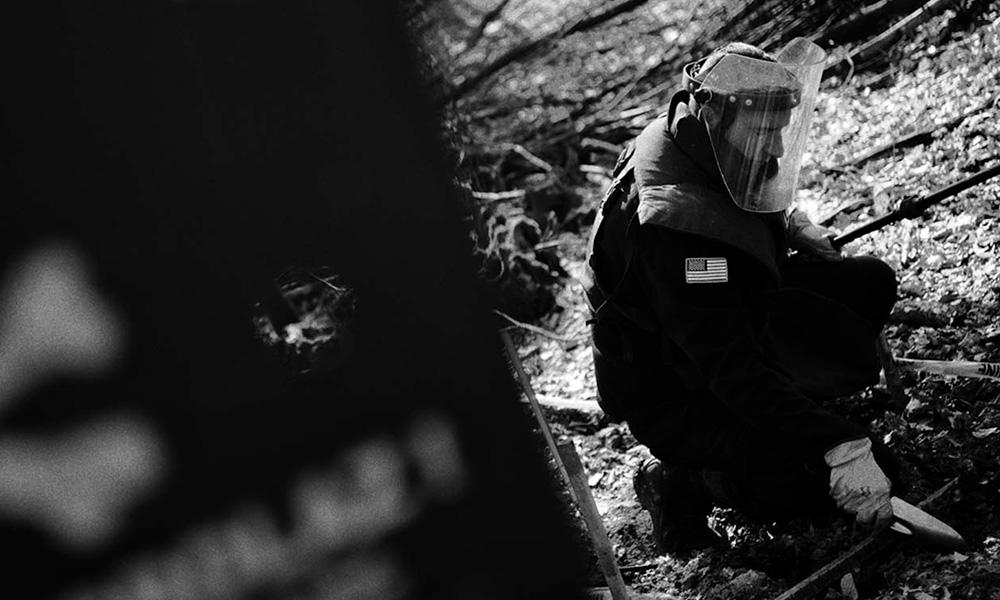
This article is brought to you by the Center for International Stabilization and Recovery (CISR) from issue 27.1 of The Journal of Conventional Weapons Destruction available on the JMU Scholarly Commons and Issuu.com.
The 1992–1995 Yugoslav wars resulted in landmines and explosive remnants of war (ERW) that continue to contaminate the Balkans. In 2021—over twenty-five years after the end of the wars—the Landmine & Cluster Munition Monitor considered Bosnia and Herzegovina to be the most explosive ordnance (EO)-contaminated country in Europe, and characterized the landmine contamination alone as "massive."1 As of March 2022, The Landmine Monitor reported that Bosnia and Herzegovina had more than 945 square kilometers of suspected hazardous areas (SHA) and more than twenty square kilometers of confirmed hazardous areas.
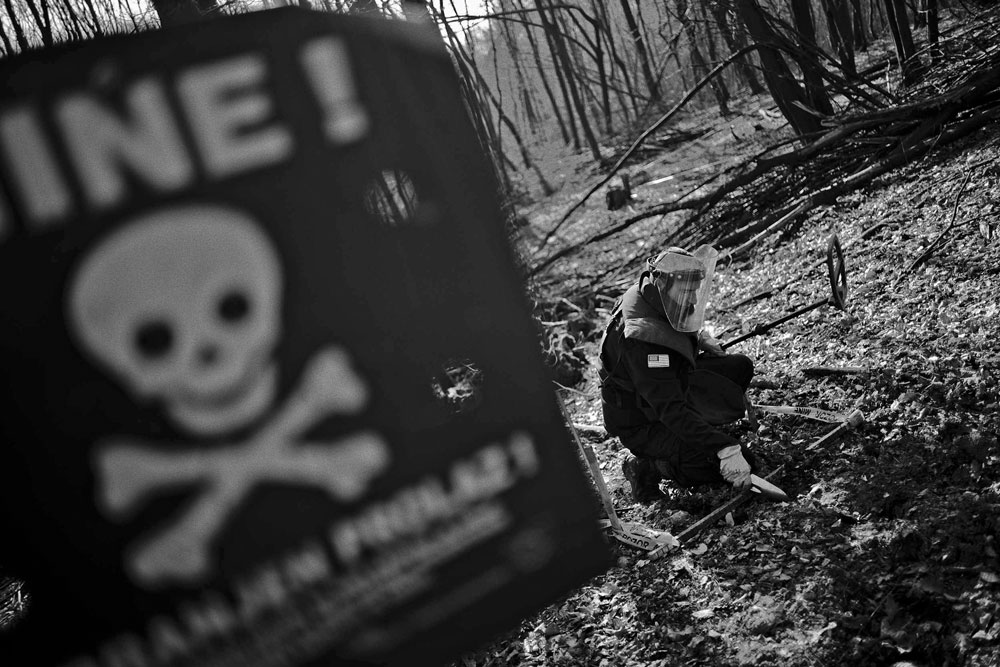
A MAG deminer working in minefield in Brčko. All images courtesy of Sean Sutton/MAG.
From 1992–2019, there have been 8,120 known casualties from EO.2 Since the decentralization of mine action operations post-war, demining teams have steadily cleared land in Bosnia and Herzegovina but operations have been hampered by funding shortfalls, the unwavering scale of EO contamination, and difficult weather conditions.
Brčko
Brčko is a strategic and sensitive area in the north of Bosnia and Herzegovina, bordering Croatia. Brčko is a self-governing entity with a diverse population representing various ethnicities and religions. Due to these attributes, it is often held up as a model for the rest of the country. However, eleven square kilometers are still suspected of landmine contamination and are a constant reminder of the Yugoslav wars. Mines Advisory Group (MAG) and Norwegian People’s Aid (NPA) are aiming to make the district impact free of landmines by 2024.
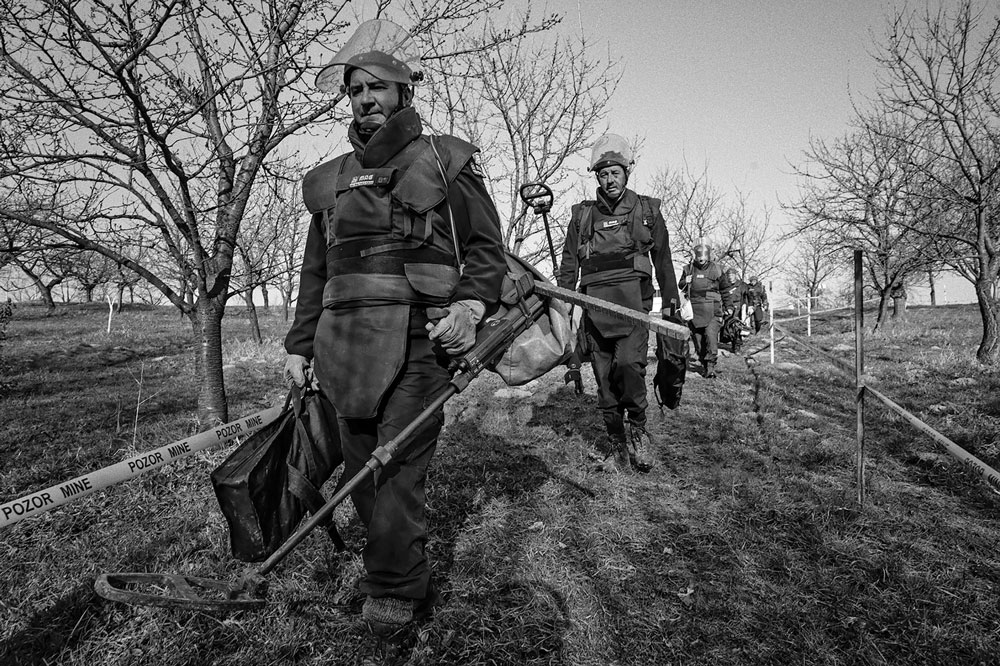
MAG demining team heads to a minefield in Brčko.
The suspected minefield area where MAG is working is located about ten kilometers south of the center of Brčko. It is flat and slightly hilly. It includes the communities of Dubravice Gornje, Dubravice Donje, Brezovo Polje, and partly the local community of Šatorovići. According to the 2013 census, there are 2,199 inhabitants in the listed local communities. According to the BHMAC plan, Brčko Istok is a mine suspected area (MSA) divided into six targeted investigations and five systematic investigations. The investigations were mostly overgrown with tall forest and low vegetation. The Lukavac stream flows through part of the MSA.
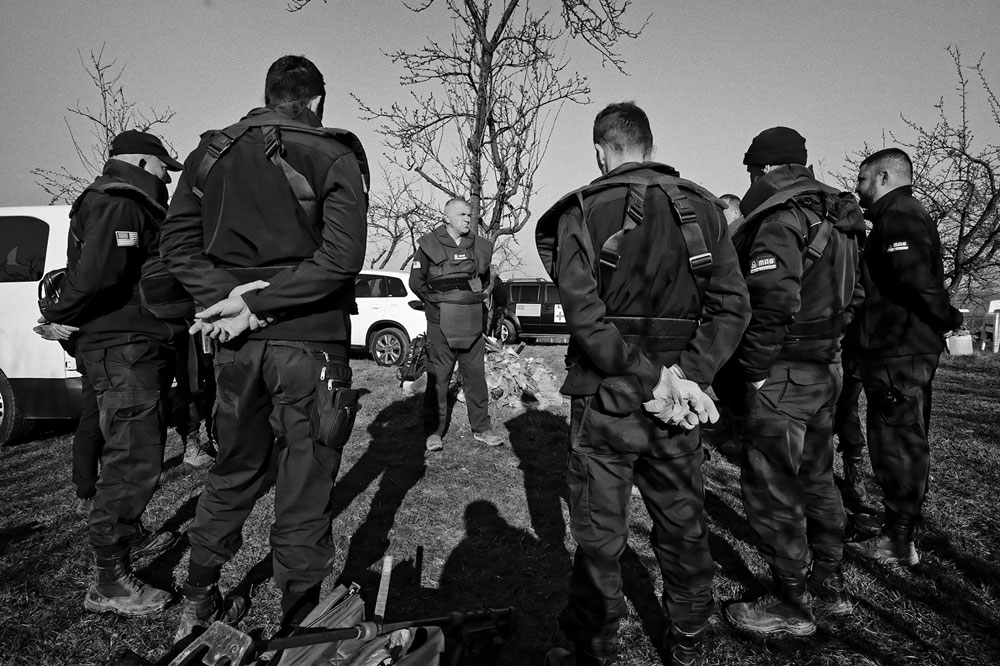
Demining team in Dubravice Gornje, Brčko.
During the war, the MSA Brčko Istok was between the lines of confrontation between the Army of the Republic of Bosnia and Herzegovina, Croatian Defense Council, and the Army of the Republic of Srpska (VRS)3 in the local communities of Dubravica Gornja and Dubravica Donja. Although not between the lines of confrontation, investigations into the area of Brezovo Polje reveal that anti-personnel mines were laid as security for the then-VRS rear war warehouse. The BHMAC project documentation contains a large number of mine records related to investigations, and it is also stated that there was a self-initiated laying of mines at the MSA where no mine records were made.
After the war, residents of the local communities began repairing buildings and clearing their properties, endangering their lives. After the war, three mine incidents and a mine accident occurred at the Brčko Istok MSA, which indicates a larger number of mines in the field, according to the project documentation. According to the MSA, there was self-initiated mine removal by the local population after the war.3
Many people have left Brčko, especially Bosnian Croats who have moved to Croatia, which is now part of the European Union. Many others have moved to Ireland, Austria, and Germany. Maybe if the land is cleared, they will come back? Who would want to live somewhere where their children might stand on a landmine in the forest?
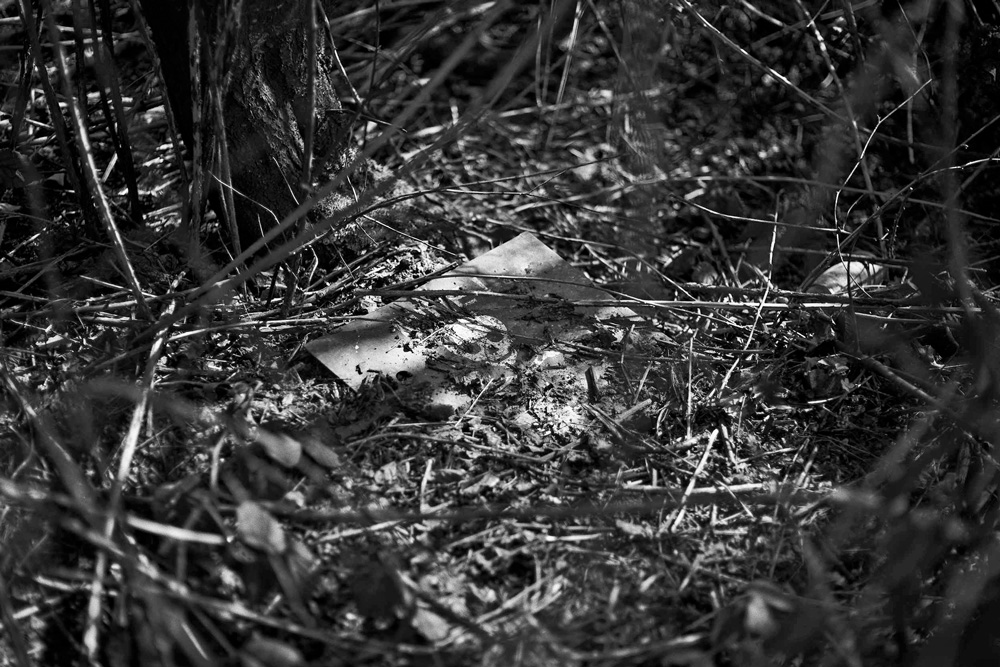
A fallen minefield warning sign on Enes Čandić’s land.
People are very suspicious in this area. Fighting moved backward and forward over a four-year period, from 1992–1995. Technical survey found one PROM-1 mine and evidence of three more. A nearby swamp was drained and two more mines were found. Non-technical survey undertaken in 2019 significantly reduced the size of the suspected area from fifty-four square kilometers to eleven square kilometers. More work must be done to help people understand the land release methodology. Landmines in this area affect people who want to use and cultivate the land for growing oats and logging. Additionally, there are huge issues when it comes to selling land. If it is suspect land, how can you sell it? The authorities stop suspected land from being sold.
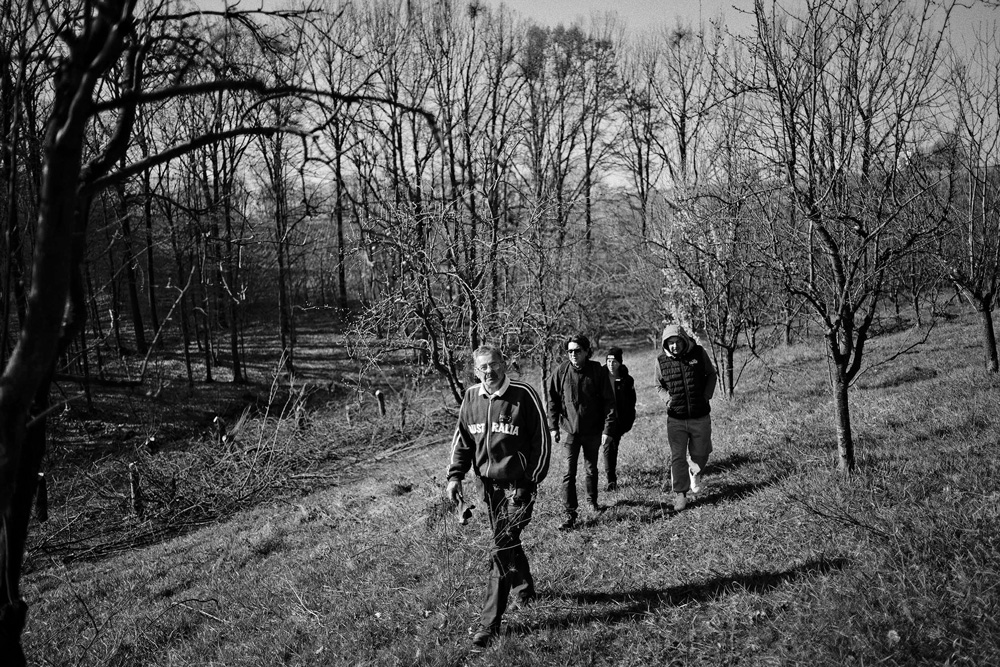
Enes Čandić with the community liaison team close to where the accident happened.
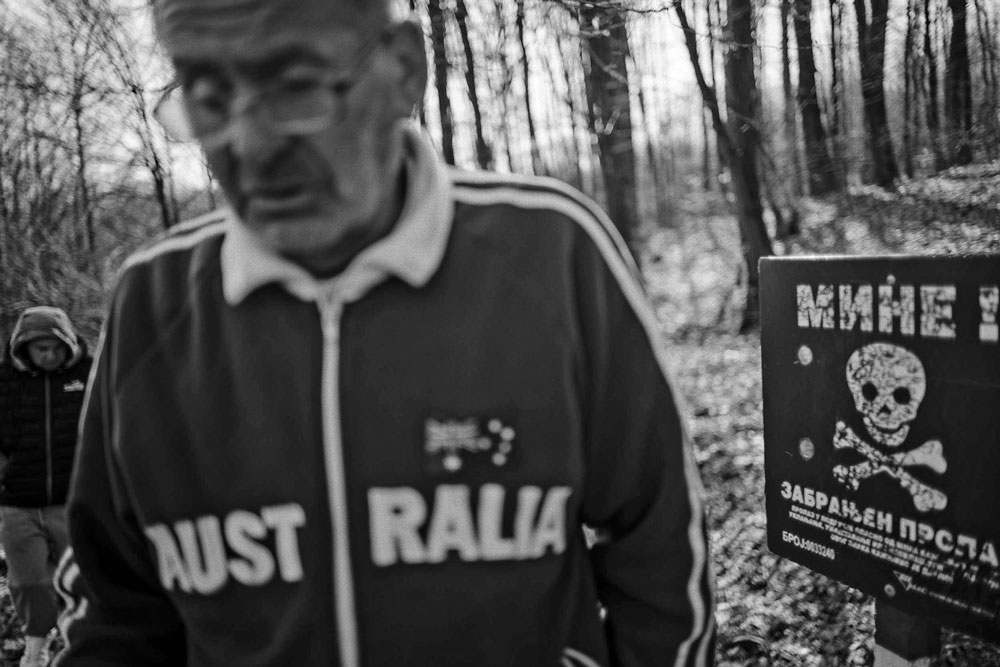
Enes Čandić walking near contaminated land.
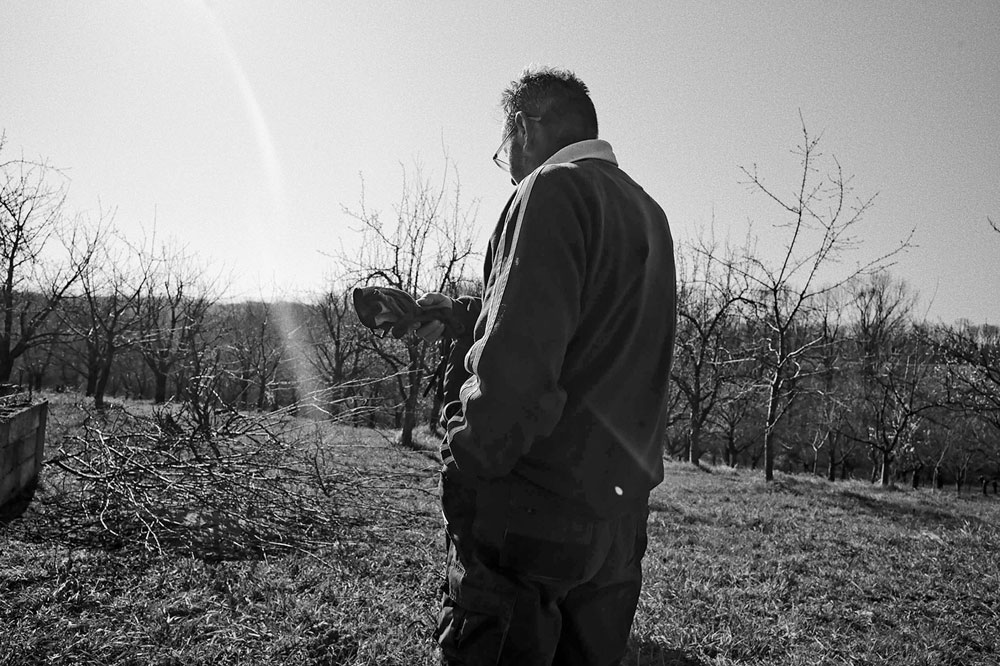
Enes Čandić grows apples, cherries, and plums.
In Gornje village, Simo Mihajlović owns an orchard, which he hasn’t had access to for thirty years as it borders a mined area. “I have always lived afraid of my land,” he said. “My grandchildren could never be free here, it was very stressful.”
Mihajlović explained that the area had been on the frontline which moved throughout the war. A PMA-3 mine was found here, located on the border of a risky area. Mihajlović also showed us the location of the PROM-1 mine, situated just a few meters from the end of his orchard. He told us he is very afraid when his grandchildren visit as he fears they will step on a mine.
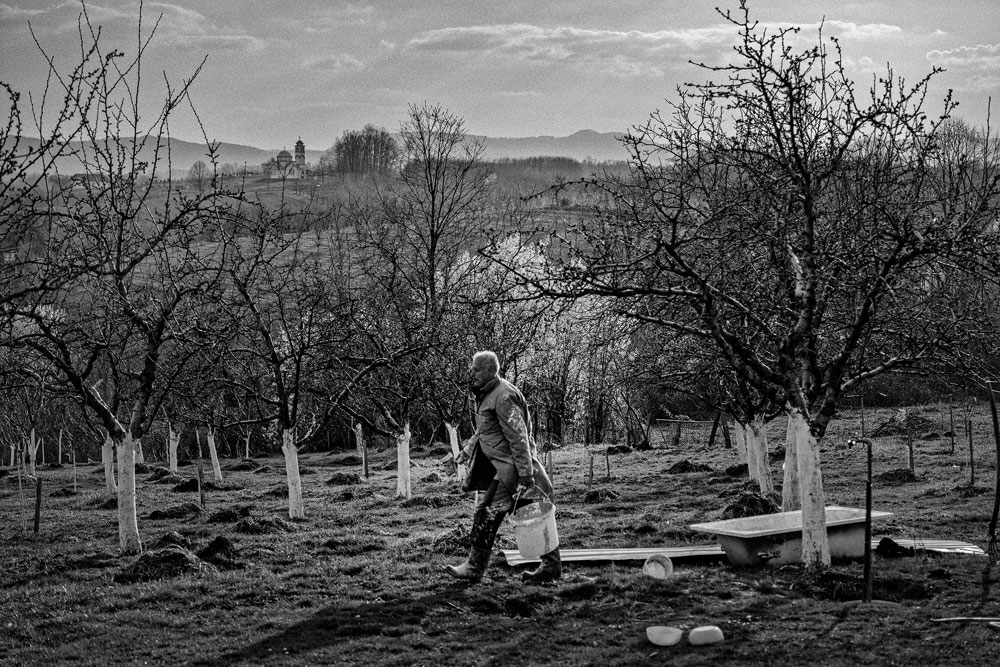
Simo Mihajlović tends to his fruit trees in Gornje Village. This was the front line during the conflict and the landmines in the gullies still act as a barrier between communities.
It is very difficult to get people to come and work here during the harvest. They come here, see the mine signs, and then leave. There is nothing else for me to do. I love my farm and growing fruit. We are living next to the landmines still, after all these years. How is that right? I don’t understand why this is not a priority, Čandić explained. Whenever I use the land I find more bullet casings—and that immediately sends me straight back to the war.
I came back to this land here in 1997. This is ancestral land; my father was here as was his father. It had been neglected and the trees were very damaged. I had 600 trees but everything was destroyed. Soldiers told me that the area was mined, especially along the gully.
I waited a long time and the authorities kept telling me that clearing my land was a priority. They said that in 1996, in 1999. In the end I spent €10,000 to have the orchard cleared of landmines.
After that, I was happy and went to work. Seven days later I was driving my tractor when there was a big explosion and lots of smoke. I knew what had happened. It was a landmine. I was with people from the village, we were cutting logs. I was so worried but everyone was fine. The machine took the blast and was destroyed. It had cost me €15,000. That night we bought a lamb and had a party to celebrate we had all survived.
Ten years later, in 2008, I was ploughing between the trees in the orchard when I uncovered two PMR-2 landmines. You can’t imagine what it is like for people. I am used to it, but when I hire workers and they don’t come back, I feel responsible. They are afraid and I am responsible—I can’t ask them to work here.
I always had to keep a keen eye on my son and daughter. My wife and I were always afraid for them and made sure they didn’t go down to the creek. I am happy MAG is here to clear the rest of the land. We know there are more mines here and we are afraid. The deminer I hired cleared just the orchard. The creek is still mined for sure.
Šatorovići, Brčko
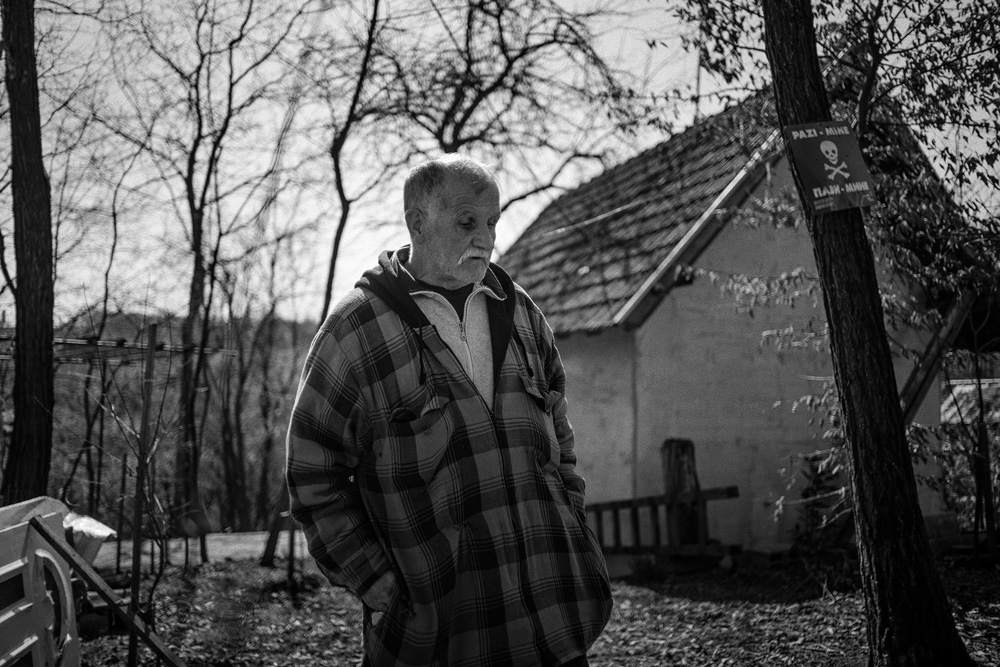
Sead Junuzović in Šatorovići, “No Man’s Land.”
My house has a very sad history. This was ‘No Man’s Land’ and my house was used as a place to exchange prisoners. They were taken here by one side at an agreed time and then the other side would come and fetch them. But they would always be dead. Tortured and dead. That is how it was. I was a major in the Army and I never allowed that kind of thing. I always stuck to the Geneva Convention and so did my soldiers. But not everyone was like me.
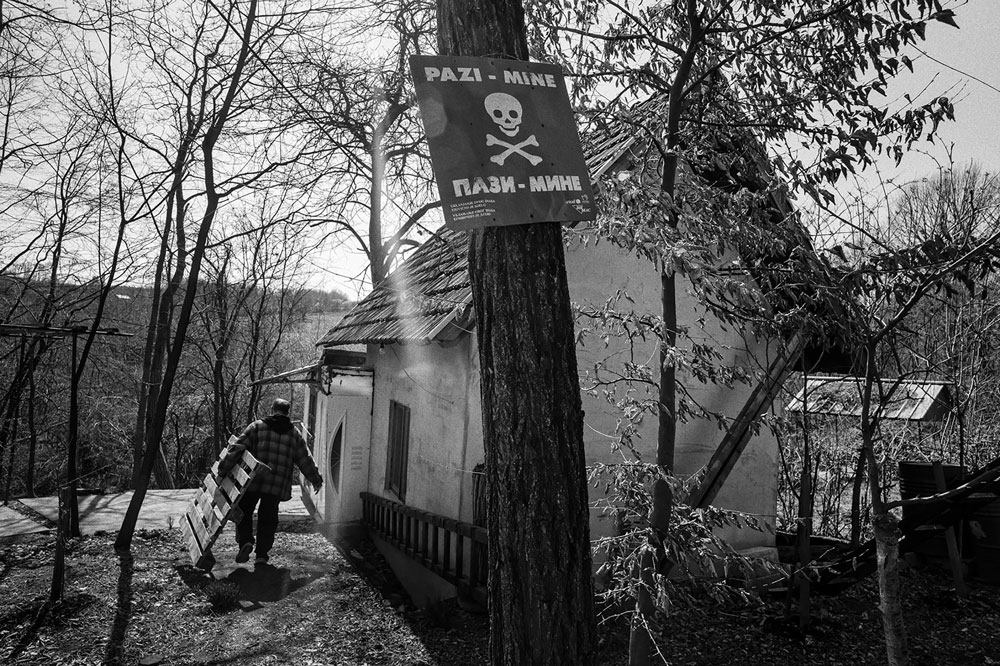
A sign marking the danger at Sead Junuzović's property.
Polje Village
MAG teams have just started working in woods run by the Forestry Department, conducting technical survey to determine the high-risk areas. The community liaison team organized for Želiko Jović, a local resident, to visit and assist in determining some of the landmarks highlighted in the minefield sketch map. One reference was a chicken shed which no longer existed. Jović was able to show where it was, and the map suddenly made sense to everyone.
The field is bordered on two sides by suspected minefields.
We are always afraid of landmines in the village. A man was killed here a few years ago trying to clear them.
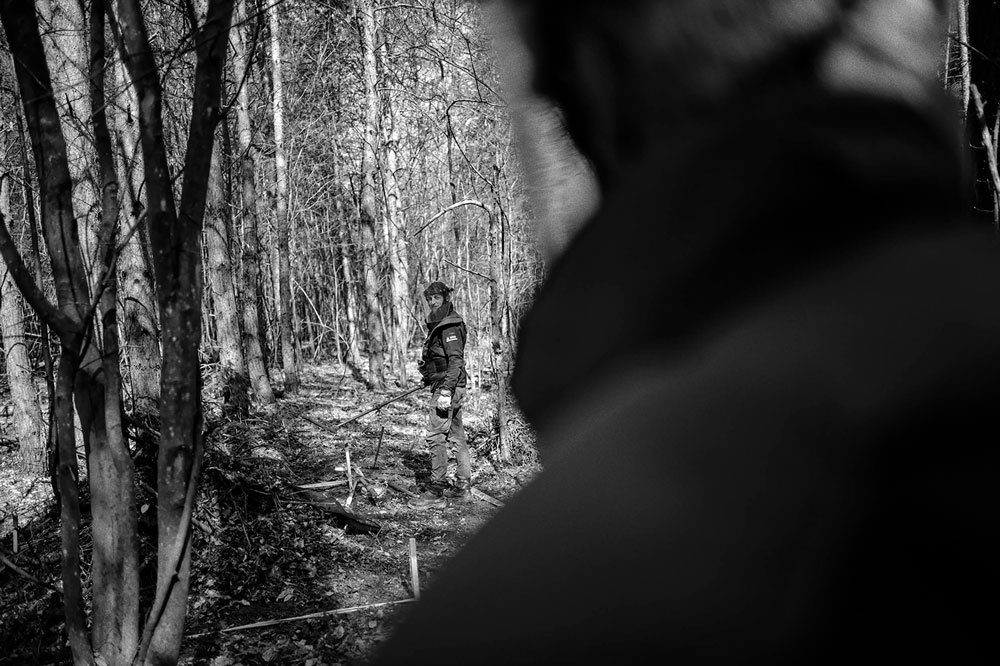
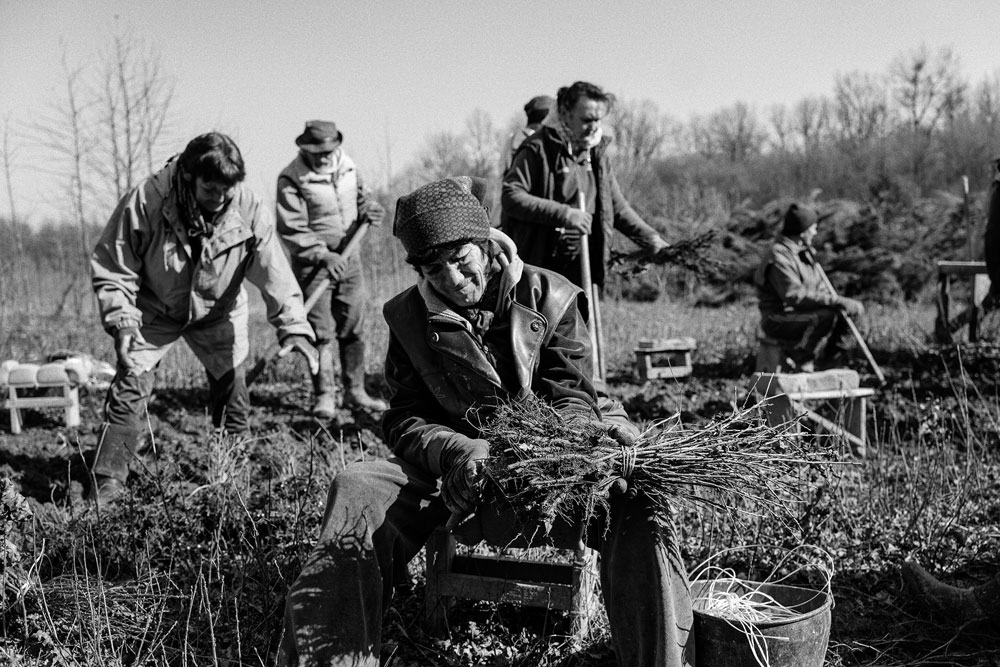
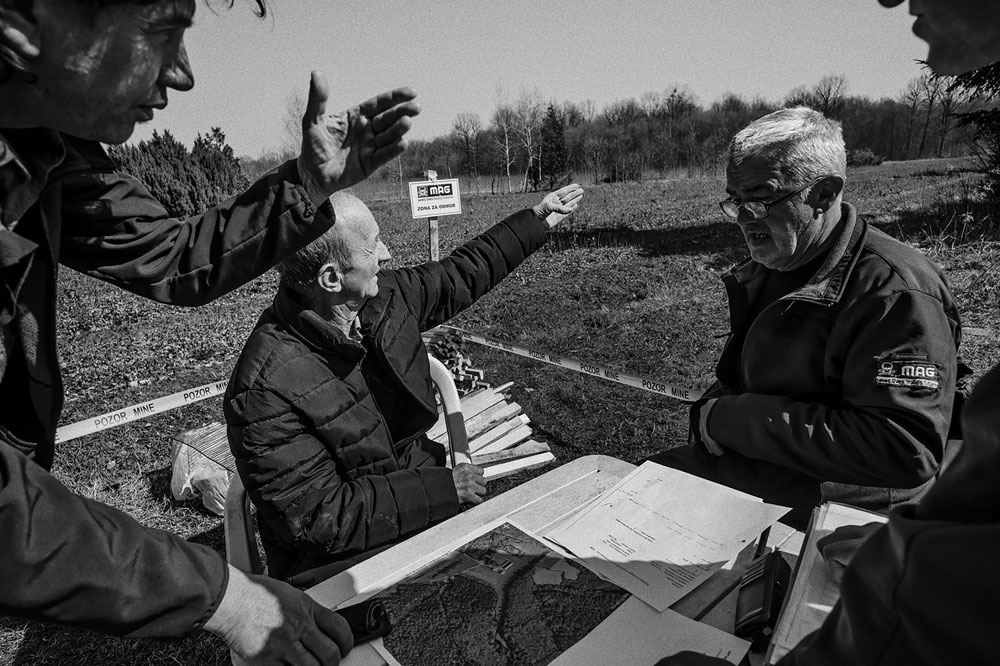
Želiko Jović works with the team to help identify landmarks found on old minefield sketch maps.
Vozuća
This area was a major frontline during the war and was a very strategic area at the time. The battle that happened here is referred to as one of the most defining in the war.
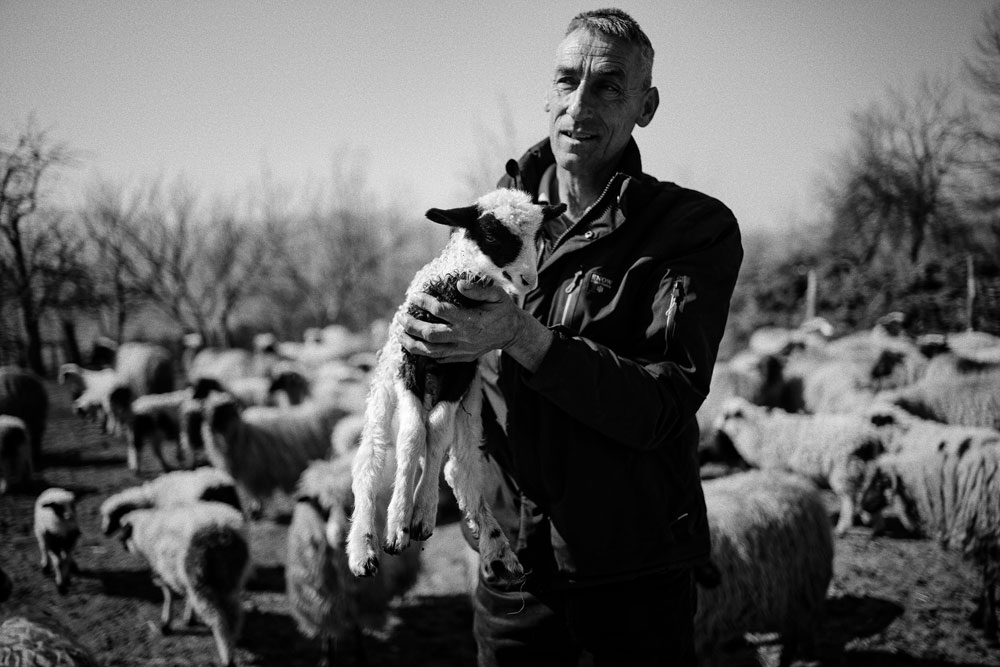
Nehrudin and Zuleja Alihodić live a hard farming life high on a hill overlooking a beautiful valley.
It is amazing to have the landmines cleared and be free. Nehrudin was a soldier here during the war and was shot in both legs. His walking has been a bit unstable ever since he recovered. He said, “War is terrible—we don’t want that to happen again. Not ever.”
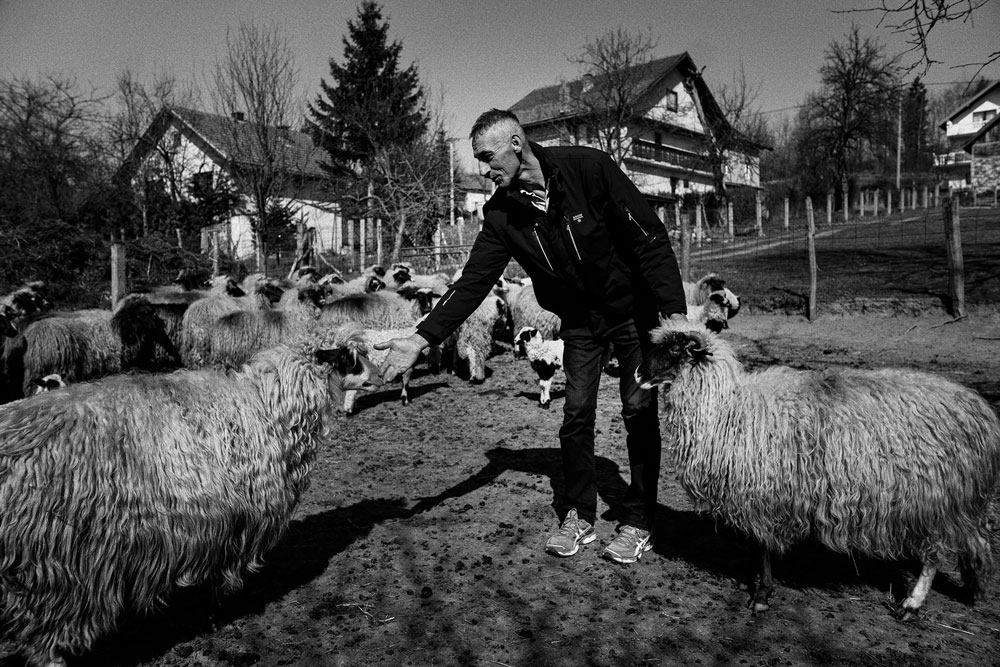
Nehrudin and Zuleja Alihodić live a hard farming life high on a hill overlooking a beautiful valley.
There was a military position at the next village called Cvijetići and there were minefields to defend it. They lost the battle and have all gone, they never came back. We knew the area was dangerous after a man lost his leg there. A cow was blown up as well. A man also used a tractor to clear vegetation from the area. When the pile of cleared bushes was burnt, it exploded. That surprised everyone, no one expected that to happen.
Zuleja came to the village when she married Nehrudin after the war. “I would look after the sheep, sometimes walk them on the hill. One day I went into the minefield and didn’t know it. This happens to a lot of people. I came back with the sheep and my husband asked me where I went with the sheep. I explained and he was very shocked. ‘That is a minefield, you shouldn’t have gone there!’ We were both shaken up. I had been so lucky. I could have been hanging in a tree in pieces.”
“It feels so much better now. To know that area is now safe is a good feeling.” Nehrudin added, ‘I was up there this morning with the sheep, it is a very good area for grazing …”
Since the war, two landmine accidents have been reported in MSA Vozuća. In one accident a member of the local community lost his cow when it activated a PROM-1 mine. A second accident occurred during sheep grazing when a shepherd stepped on a PMA-3 mine, losing his leg. In the summer of 2021, two hunters were killed in a mine accident just two kilometers away from the MSA Vozuća.
During clearance in Vozuća, MAG found 102 anti-personnel mines, six anti-tank mines, and seventy items of unexploded ordnance (UXO). The area released is two square kilometers, and MAG cleared 143 square kilometers, with 530 square kilometers reduced.
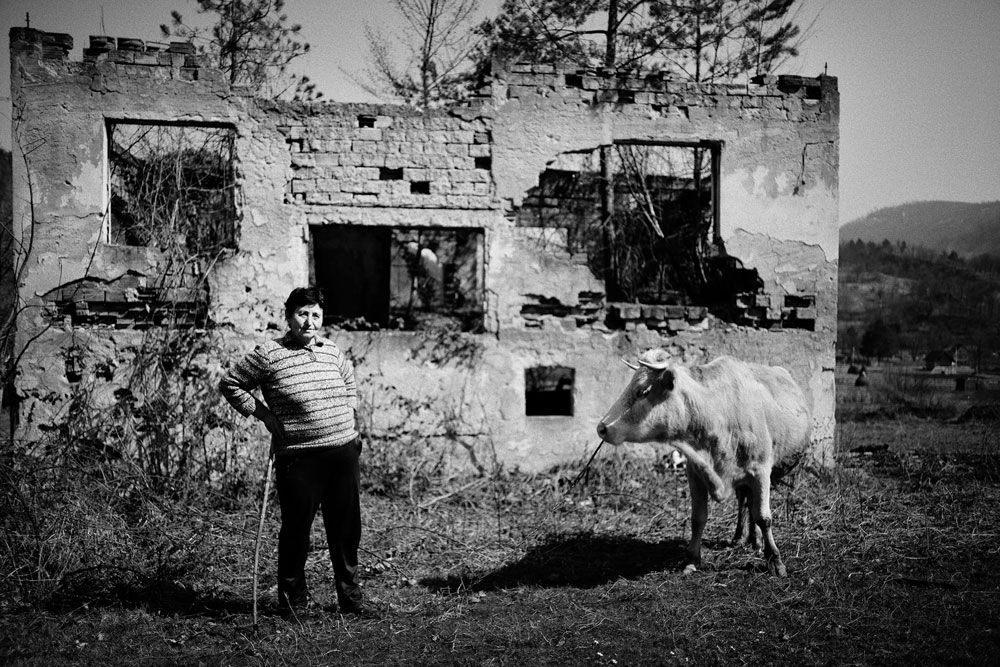
Ruža Spasojević returned home to her house in Vozuća in 2002.
When we came back everything was destroyed. This hamlet of eight houses was mostly damaged. Mine was one of the few not burnt to the ground, so I was lucky. All the windows were looted, anything useful gone. Organizations like [ the Swedish International Development coordination Agency ] SIDA helped us and gave us materials and we rebuilt our farm slowly. We knew that there were landmines around, people had told us. We were always careful but lucky not to lose any animals. My mother was very worried about me living here. Now MAG has cleared the landmines, I really appreciate the second chance it has given me to have a life. It makes me very happy.
MAG teams found twenty-four landmines and twenty UXO on the hillside behind Ruža’s house. The closest landmine was just fifteen meters away. She is now a widow, and her children live overseas. “Now I have freedom. Freedom to walk where I want.”
Čavas
I have been with MAG for nine months. It is my first job and I love it. It feels great to be doing something that helps other people. Also, I love nature, so it is nice to be working outside rather than in a hospital. Working with MAG can help me with my career in other ways too. I am saving up to study more. I want to be a pediatric doctor, that’s my plan.
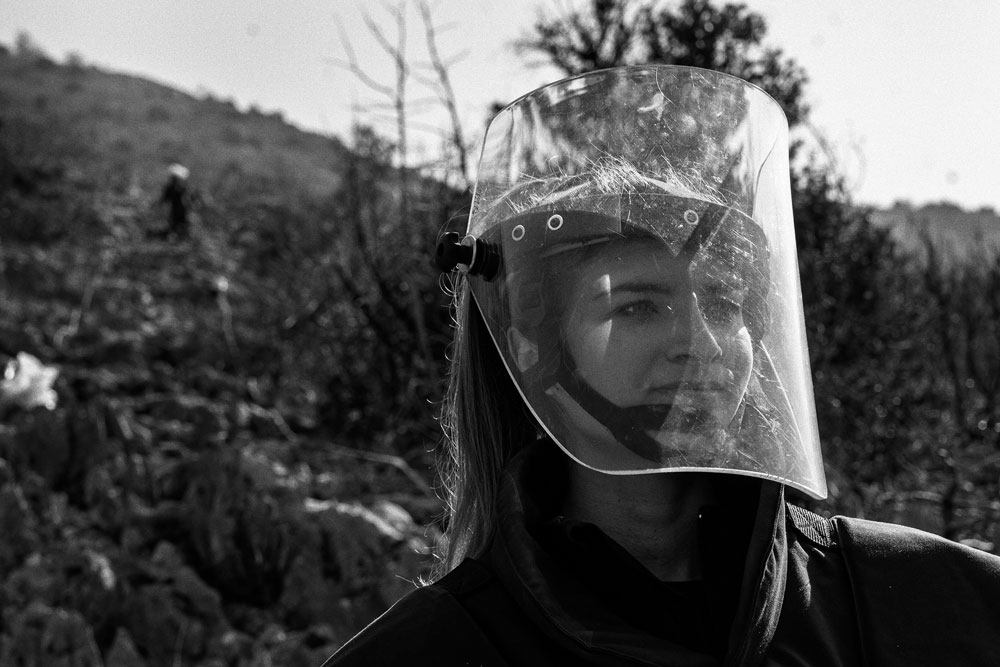
Merjema Hodžić, MAG trauma medic.
I worked as a deminer for thirteen years with different organizations. I have been with MAG for five of those years. I was promoted to team leader just five months ago and I am very happy about that. I am still learning of course, and I have established a good relationship with the team. The work we do is vital. People are still going home, coming back. You see that here in this village. Landmines are one of the problems. Often it is the big blockage. People are always very happy to see us, they are so grateful—we see them every day.
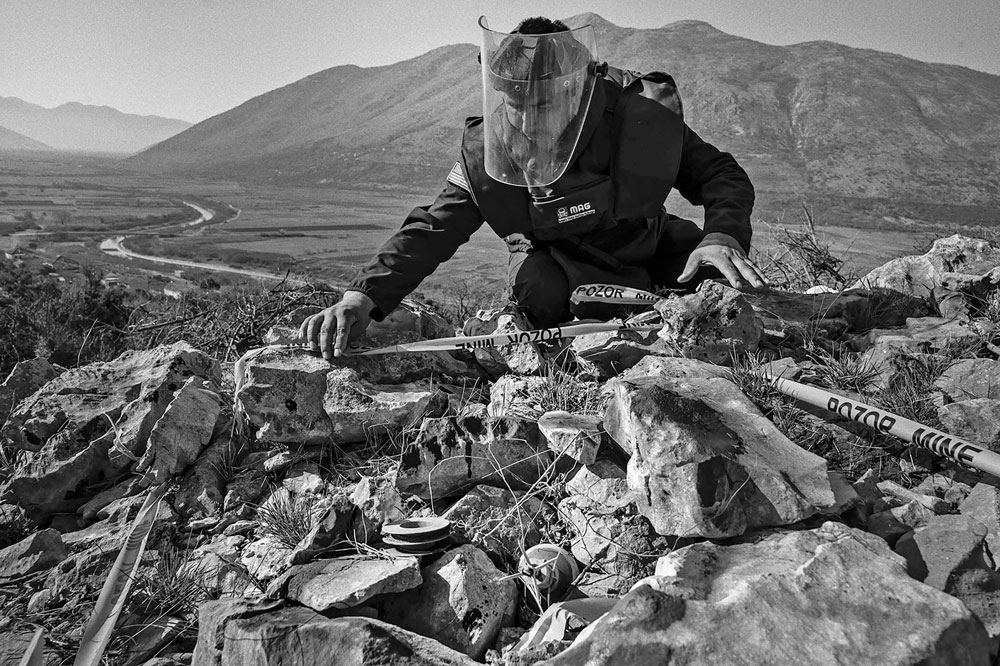
Miodrag Živković, MAG team leader.
Every time I find a landmine, I feel like I have saved a life. I have found more than a thousand in my career—that is very satisfying.
The PROM-1 landmine is a very dangerous mine. I always approach them with great care. This is the most dangerous mine in Bosnia, and they have killed many people. Usually, they are buried with the top sticking out which is attached to a tripwire—1.5 kilos of pressure will initiate it.
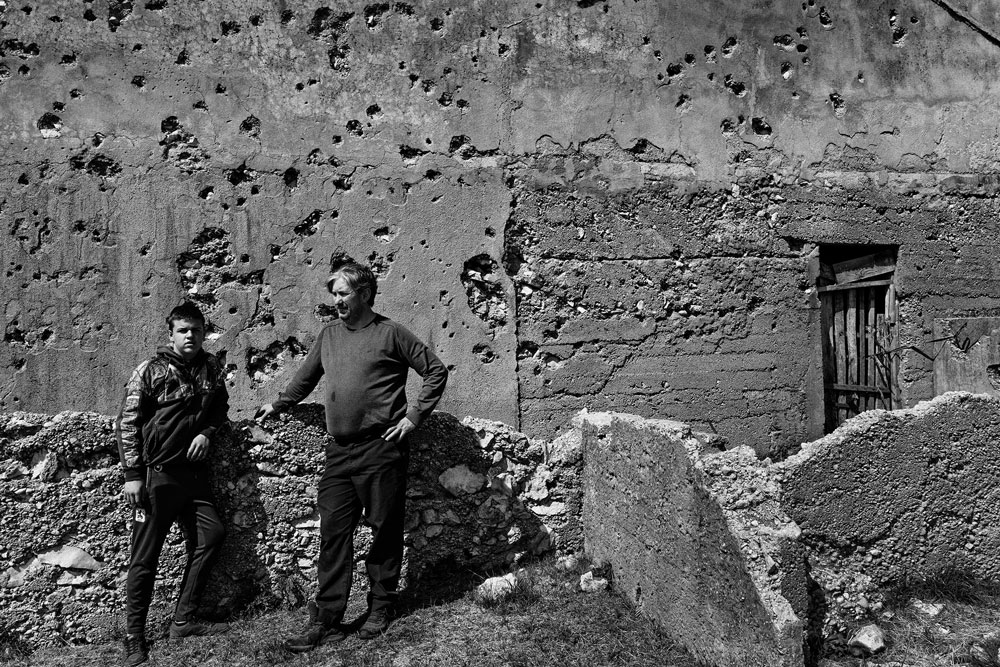
Veljko with his uncle.
Speaking of his grandfather, thirteen-year-old Velijko from Slobodan stated, “My family have lost a lot of cows to landmines. The last one died in 2017 when I was nine-years-old. My grandfather cleared about 1,000 landmines. That’s why they called him mongoose.”
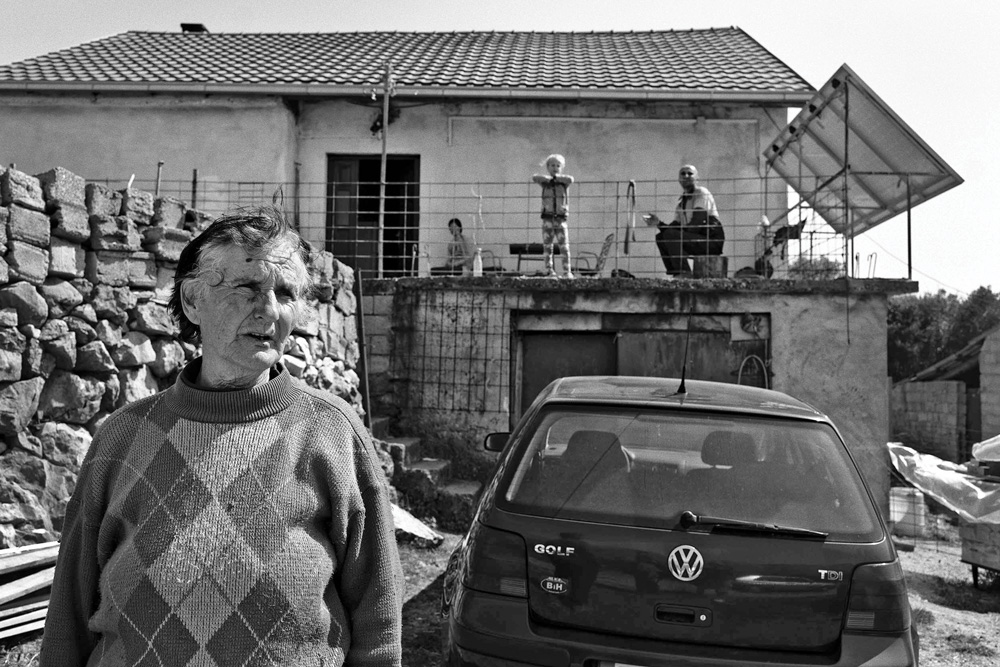
Vinka Milosević with son Velmir and grandchildren Teodora, Tasa, and Vasilije.
Only two houses have been fully renovated in the village. The road here is very bad, there is no electricity and many landmines. There is no school, no water, no investment. I was the first one to come back here in 2007. The kids know of the dangers, they hear the [mines] exploding in fires and when animals stand on them. They are afraid and always ask about the mines.
Sean Sutton
Mines Advisory Group
International Communications Manager
Instagram: @Seansuttonphoto
https://www.maginternational.org/
 Sean Sutton is an award-winning photojournalist; his well-known pictures show the impact of landmines and explosive remnants of war on communities and have been published and exhibited all over the world. His book documenting how unexploded ordnance affects people in Laos was runner-up for the Leica European Publisher’s Award. Sutton is MAG’s International Communications Manager and has worked for the organization since 1997.
Sean Sutton is an award-winning photojournalist; his well-known pictures show the impact of landmines and explosive remnants of war on communities and have been published and exhibited all over the world. His book documenting how unexploded ordnance affects people in Laos was runner-up for the Leica European Publisher’s Award. Sutton is MAG’s International Communications Manager and has worked for the organization since 1997.
